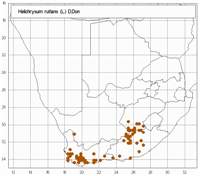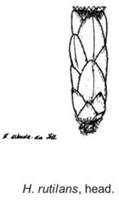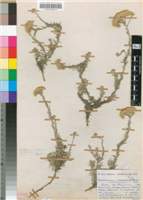Common names:
Sandsewejaartjie
Origin of name:
rutilans = red with yellow admixture, reddish orange
Diagnostic characters:
Lemon-yellow bracts
Small heads in dense terminal clusters
Narrow grey leaves, often folded
Description:
Dense twiggy shrublet up to 600 mm tall and as much across, or sometimes lax, branches very leafy, both they and the leaves enveloped in closely woven silvery grey indumentum with 'tissue-paper' surface, becoming woolly when old, somewhat viscid. Leaves very variable in size and shape, mostly 6�30 x 1�3 (�6) mm, spathulate, narrowly obovate, oblong or linear, often folded lengthwise, apex sub-acute, mucronate, often recurved, base very shortly decurrent. Heads heterogamous, or rarely homogamous on the same plant, cylindric, c. 3�4 x 1.5 (�2.5) mm, many in clusters crowded in terminal corymbose panicles. Involucral bracts in 4 series, graded, inner equaling flowers, imbricate, ovate-lanceolate, acute, pellucid, glossy, pale lemon-yellow, not radiating. Receptacle smooth. Flowers 3�5 (�8), (0�) 1 (�2) female, 2�4 (�7) homogamous, bright yellow. Achenes less than 1 mm long, glabrous. Pappus bristles 2�4, scabrid, nearly equaling corolla, or occasionally wanting.
Flowering in any month.
Distribution:
A constituent of shrub communities on sandy, shaly or stony soils. Ranges from the Cape Peninsula through Piquetberg, Malmesbury, Ceres, Worcester, Caledon, Robertson, Bredasdorp, Swellendam and Riversdale districts to Humansdorp and Uitenhage, thence north to Cathcart, Cradock, Tarka, Middelburg, Queenstown, Aliwal North, and Hay districts and the southern Free State near Fauresmith, Philippolis and Bethulie.
Fynbos, Nama Karoo, Grassland and Savanna Biomes.
Notes:
Readily confused with H. dasycephalum which, however, has mainly silvery, not lemon-yellow, involucral bracts, and these are webbed together with delicate 'tissue-paper-like' indumentum composed of woolly hairs. The area of H. dasycephalum lies east of that of H. rutilans, overlapping only in the Queenstown area (c. 27�E).
Taxonomy:
Literature:
Helichrysum rutilans (L.) D. Don in Sweet, Hort. Brit. 223 (1826); Hilliard & Burtt in Bot. J. Linn. Soc. 82: 262 (1981).
Type:
Gnaphalium sheet no. 6 in herbarium Cliff. (BM).
Synonym(s):
Gnaphalium rutilans L., Sp. P1. 854 (1753).
G. parviflorum Lam., Encycl. 2: 748 (1788). Helichrysum parviflorum (Lam.) DC., Prodr. 6: 203 (1838); Harv. in F.C. 3: 247 (1865). Type: Cape of Good Hope (P-LAM).
G. citrinum Schrank in Denkschr. K. Akad. Wiss. M�nh. 8: 152 (1824), non Lam. (1778). Type: Cape of Good Hope, Brehm s.n. (M, holo.).
Helichrysum parviflorum var. longifolium DC., l.c.Type: Cape, Dr�ge 5755 (G-DC, holo.).
H. parviflorum var. latifolium DC., l.e. Type: Cape, Sneeuwberg, 3 000�4 000 ft, Dr�ge 5786 (G-DC, holo.).
H. manopappum O. Hoffm., Pl. Penther. in Annln naturh. Mus. Wien 24: 299 (1910). Type: Cape, Zonder Einde Rivier, Loskraal, Penther 1179 (BM; BOL; M; S, iso.).
H. niveum sensu Moeser in Bot. Jb. 44: 252 (1910); Levyns in Adamson & Salter, Fl. Cape Penins. 783 (1950), non (L.) Less.
Vouchers:
Acocks 17639 (PRE); Compton 18508 (NBG); Esterhuysen 23806 (BOL; PRE); Leistner 1110 (PRE); Nordenstam 3228 (NU; S).

